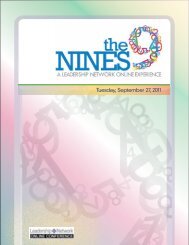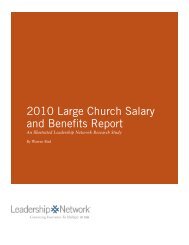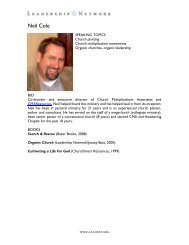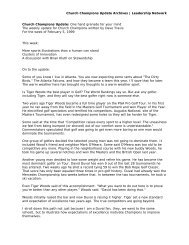ARE WE A PEOPLE AT HALF TIME? - Leadership Network
ARE WE A PEOPLE AT HALF TIME? - Leadership Network
ARE WE A PEOPLE AT HALF TIME? - Leadership Network
Create successful ePaper yourself
Turn your PDF publications into a flip-book with our unique Google optimized e-Paper software.
“THE NEXT CHURCH”<br />
was the cover story of the August<br />
issue of The Atlantic Monthly.<br />
V O L U M E 2 , N U M B E R 4 D E C E M B E R , 1 9 9 6<br />
F R O M L E A D E R S H I P N E T W O R K<br />
Set amidst the changing landscape<br />
of American religious and social life,<br />
it focused on the emergence of<br />
the large pastoral church and<br />
represented more than a year of<br />
research, interviews with pastors,<br />
church leaders and others on<br />
the part of the author,<br />
Charles Trueheart.<br />
We thank The Atlantic Monthly<br />
for permission to excerpt the article<br />
for the readers of NEXT.<br />
THE STAFF OF LEADERSHIP NETWORK<br />
INSIDE NEXT<br />
■ VITAL ■<br />
READER RETURN RESPONSE REQUIRED<br />
(back of dust cover)<br />
Seamless multimedia worship, round-the-clock niches of work and<br />
service, spiritual guidance, and a place to belong: in communities<br />
around the country, the old order gives way to the new...<br />
COVER STORY<br />
<strong>WE</strong>LCOME TO THE NEXT CHURCH<br />
■<br />
1997 LEADERSHIP CONFERENCES<br />
(page 8-9)<br />
■<br />
THE BOOKSHELF (page 10)<br />
■<br />
LEADERSHIP NETWORK FORUMS<br />
(page 11)<br />
■<br />
FAX FORUM QUESTIONS (page 12)<br />
■<br />
NETFAX (page 13)<br />
■<br />
LEADERSHIP NETWORK <strong>WE</strong>B SITE<br />
(page 14)<br />
■<br />
<strong>WE</strong>B.W<strong>AT</strong>CH (page 15)<br />
■<br />
1997 GEN-X FORUM (page 16)<br />
No spires. No crosses. No robes. No<br />
clerical collars. No hard pews. No kneelers.<br />
No biblical gobbledygook. No prayerly<br />
rote. No fire, no brimstone. No pipe organs.<br />
No dreary eighteenth-century hymns. No<br />
forced solemnity. No Sunday finery. No<br />
collection plates.<br />
The list has asterisks and exceptions,<br />
but its meaning is clear. Centuries of<br />
European tradition and Christian habit are<br />
deliberately being abandoned, clearing the<br />
way for new, contemporary forms of worship<br />
and belonging.<br />
The Next Church, as the independent<br />
and entrepreneurial congregations that are<br />
adopting these new forms might collectively<br />
be called, is drawing lots of people,<br />
including many Americans with patchy or<br />
blank histories of churchgoing. It constitutes,<br />
its champions believe, a distinctly<br />
American reformation of church life, one<br />
that transcends denominations and the<br />
bounds of traditional churchly behavior. As<br />
such, it represents something more: a<br />
reconfiguration of secular communities,<br />
not just sacred ones.<br />
Social institutions that once held civic<br />
life together—schools, families, governments,<br />
companies, neighborhoods, and<br />
even old-style churches—are not what they







